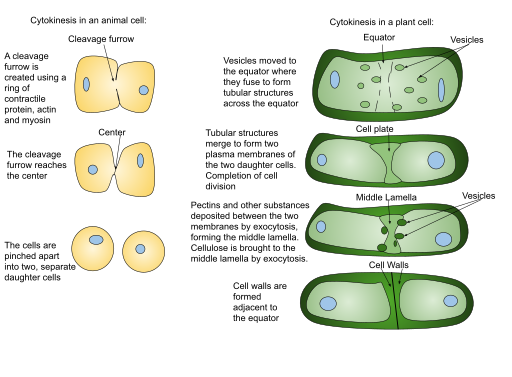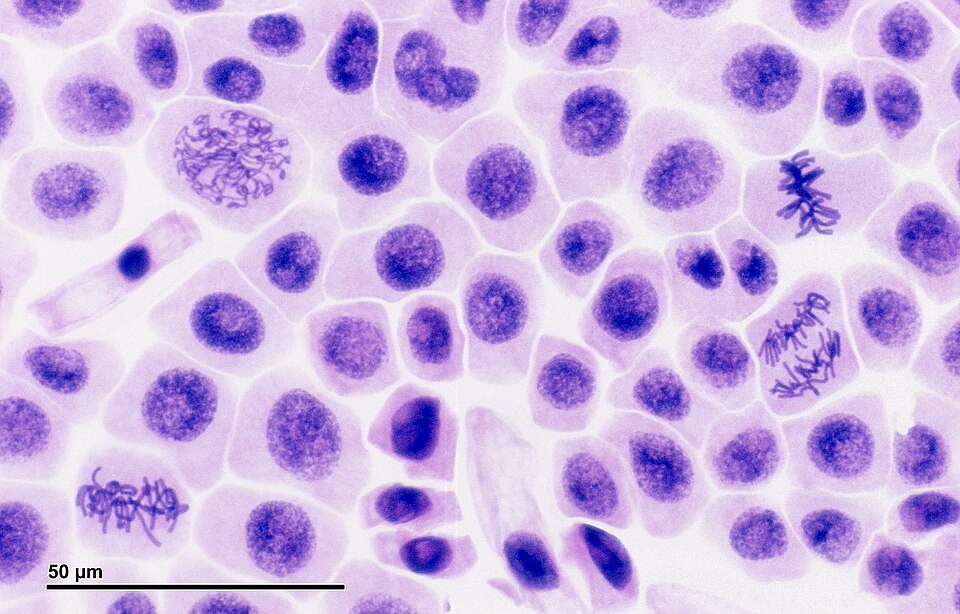OCR Specification focus:
‘Explain mitotic stages and significance for growth, tissue repair and asexual reproduction.’
Mitosis is a precise process of nuclear division that ensures genetic continuity by producing two identical daughter cells. It is vital for growth, repair, and asexual reproduction.
The Cell Cycle and Context of Mitosis
Mitosis occurs as part of the cell cycle, following interphase, when DNA and organelles are replicated. The mitotic phase includes nuclear division (mitosis) and cytoplasmic division (cytokinesis). Accurate mitotic division maintains the organism’s chromosome number, ensuring genetic stability between generations of cells.
Interphase: Preparation for Division
Although not technically a stage of mitosis, interphase precedes it and prepares the cell for division. During interphase:
DNA replicates during the S phase, forming identical sister chromatids joined at the centromere.
Proteins and organelles required for division are synthesised.
The cell increases in size and accumulates energy reserves for mitosis.
Cells spend most of their time in interphase, ensuring all necessary materials are present for accurate division.
The Stages of Mitosis
Mitosis consists of four main stages — prophase, metaphase, anaphase, and telophase — followed by cytokinesis. Each stage involves a series of coordinated events ensuring the correct distribution of chromosomes.

Schematic of mitosis showing chromosome condensation in prophase, alignment at the metaphase plate, chromatid separation in anaphase, and nuclear reformation during telophase. The diagram emphasises the role of the spindle and the centromere/kinetochore attachments that ensure accurate segregation. This visual directly mirrors the stage sequence required by the specification. Source.
Prophase
Prophase marks the onset of mitosis, where visible chromosomal structures begin to form.
Key events include:
Chromatin condenses into distinct chromosomes, each composed of two identical sister chromatids.
The nucleolus disappears, and the nuclear envelope breaks down.
Centrioles (in animal cells) migrate to opposite poles of the cell, organising the spindle fibres made of microtubules.
Spindle fibres attach to chromosomes at their centromeres.
These changes prepare chromosomes for alignment at the cell’s equator.
Metaphase
Metaphase ensures chromosomes are correctly aligned before separation.
Key events include:
Spindle fibres guide the chromosomes to the cell equator.
Chromosomes align along the metaphase plate, with centromeres facing opposite poles.
The spindle checkpoint verifies that all chromosomes are properly attached, preventing errors such as non-disjunction (incorrect separation).
The metaphase stage is often used in microscopy to study chromosome morphology because the chromosomes are highly condensed and visible.
Anaphase
Anaphase is the stage of chromatid separation.
Key events include:
Centromeres divide, allowing sister chromatids to separate.
Spindle fibres shorten, pulling chromatids to opposite poles using motor proteins.
The separated chromatids are now called daughter chromosomes.
The precise separation ensures each new nucleus receives an identical set of chromosomes.
Telophase
Telophase is the final stage of nuclear division.
Key events include:
Chromosomes decondense back into chromatin.
Nuclear envelopes reform around each set of chromosomes, producing two distinct nuclei.
Nucleoli reappear, and the spindle fibres disassemble.
At this stage, the cell effectively has two genetically identical nuclei.
Cytokinesis
Cytokinesis divides the cytoplasm, completing the formation of two daughter cells.

Comparison of animal cell cytokinesis via contractile ring/cleavage furrow and plant cell cytokinesis via vesicle-mediated cell plate formation. Labels highlight the actin ring in animals and the Golgi-derived vesicles/phragmoplast in plants. This includes standard textbook detail that matches the syllabus emphasis on cytokinesis differences. Source.
In animal cells, a cleavage furrow forms when the cell membrane constricts around the centre.
In plant cells, vesicles from the Golgi apparatus align at the centre, forming a cell plate that develops into a new cell wall.
Cytokinesis ensures each daughter cell contains a full complement of organelles and cytoplasmic contents.
Significance of Mitosis
Mitosis is essential for several biological functions that sustain multicellular life.
Growth
Through repeated rounds of mitosis, an organism increases its cell number while maintaining genetic consistency.
Growth occurs during development from a zygote to a mature organism.
Controlled mitosis ensures proportional tissue expansion.
Disruptions in mitotic control can lead to tumour formation or cancer, where cells divide uncontrollably.
Tissue Repair
Mitosis enables the replacement of damaged or dead cells, maintaining tissue integrity.
Examples include:
Skin regeneration following injury.
Liver regeneration after partial removal.
Repair of blood vessel linings and intestinal epithelium.
This capacity for renewal ensures organisms sustain their physiological functions despite daily cellular wear and tear.
Asexual Reproduction
In unicellular eukaryotes and some multicellular organisms, mitosis is the mechanism of asexual reproduction.
Examples include:
Amoeba dividing by mitosis to produce identical offspring.
Plants reproducing via vegetative propagation, such as the formation of runners or bulbs.
This results in clonal populations, where all offspring are genetically identical to the parent organism, allowing stable transmission of advantageous traits.
Mitotic Regulation and Checkpoints
Mitosis is tightly controlled by cell cycle checkpoints to ensure DNA integrity and prevent division errors.
Key checkpoints include:
G1 checkpoint: verifies cell size, nutrients, and DNA integrity.
G2 checkpoint: ensures DNA replication has been completed without damage.
Spindle checkpoint (metaphase): confirms all chromosomes are attached to spindle fibres before separation.
These regulatory mechanisms involve cyclins and cyclin-dependent kinases (CDKs) that modulate cell cycle progression.
Cyclin: A regulatory protein that controls progression through the cell cycle by activating specific CDKs.
Failure of these checkpoints can cause chromosomal abnormalities or uncontrolled proliferation, highlighting their importance in maintaining genetic stability.
Chromosome Number and Genetic Stability
Each daughter cell produced by mitosis receives an identical diploid set of chromosomes.
This preserves the species’ chromosome number and genetic identity through successive cell generations.
Diploid: A cell containing two complete sets of chromosomes, one from each parent (symbolised as 2n).
In contrast, meiosis halves the chromosome number for gamete formation, whereas mitosis maintains it, emphasising their distinct biological purposes.
Microscopic Observation of Mitosis
In practical studies, mitotic stages can be observed in root tip squashes or stained onion root preparations.

Photomicrograph montage from Allium (onion) root meristem showing cells in prophase, metaphase, anaphase, and telophase. The images illustrate condensed chromosomes, metaphase alignment, sister chromatid separation, and chromosome decondensation with nuclear envelope reformation. This is a real-world counterpart to the schematic sequence; no extra stages beyond the syllabus are included. Source.
Typical observations include:
Highly condensed chromosomes in metaphase and anaphase.
Visible spindle fibres and cell plates during late mitosis.
These practicals reinforce understanding of mitotic dynamics and its significance in biological continuity.
FAQ
Separation at the centromere ensures that each daughter nucleus receives an identical copy of every chromosome. If chromatids failed to separate properly, one cell might receive too many or too few chromosomes, leading to aneuploidy.
Accurate chromatid separation depends on the spindle apparatus pulling chromatids apart through microtubule shortening and motor proteins at the kinetochore. This precision maintains genetic stability across successive cell generations.
The spindle apparatus is formed from microtubules originating at the centrosomes (or microtubule organising centres).
Its key roles include:
Organising and attaching to chromosomes via kinetochores on centromeres.
Aligning chromosomes on the metaphase plate.
Shortening microtubules to separate chromatids during anaphase.
Spindle formation relies on tubulin polymerisation, and its breakdown after mitosis allows microtubule components to be recycled for future divisions.
During prophase, chromosomes condense, the nuclear envelope breaks down, and the spindle forms.
In telophase, these processes are reversed:
Chromosomes decondense into chromatin.
The nuclear envelope reforms around each chromosome set.
The nucleolus reappears, and spindle fibres disassemble.
This reversal restores typical interphase nuclear structure, preparing each new cell for normal metabolic activity.
If cytokinesis did not occur, the result would be a multinucleate cell, containing two or more nuclei within a single cytoplasm.
Such cells may still function but are often larger and less efficient in nutrient exchange. Some specialised cells, like skeletal muscle fibres, naturally remain multinucleate to support high metabolic demand, but in normal tissue growth this would represent a cell division error.
The mitotic index measures the proportion of cells in mitosis at a given time:
High mitotic index → rapid cell division (common in developing tissues or tumours).
Low mitotic index → slow division or high differentiation.
Clinically, it helps assess tumour aggressiveness and monitor the effects of anti-cancer treatments that target dividing cells. Biologists also use it to study growth rates in plant root tips and other actively dividing tissues.
Practice Questions
Question 1 (2 marks)
Describe what happens to the chromosomes during anaphase of mitosis.
Mark Scheme:
1 mark – Reference to sister chromatids separating at the centromere.
1 mark – Description that chromatids are pulled to opposite poles of the cell by shortening spindle fibres (or by spindle contraction).
Question 2 (5 marks)
Explain the importance of mitosis for growth, repair and asexual reproduction in multicellular organisms.
Mark Scheme:
1 mark – States that mitosis produces genetically identical daughter cells (same DNA/chromosome number as parent).
1 mark – Explains that this allows growth by increasing the number of body cells while maintaining genetic stability.
1 mark – Describes how repair occurs through replacement of damaged or dead cells using identical copies.
1 mark – Mentions asexual reproduction in some organisms (e.g. plants or single-celled eukaryotes), producing offspring genetically identical to the parent.
1 mark – Notes that identical genetic material ensures continuity of function and characteristics across tissues or generations.

